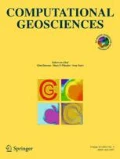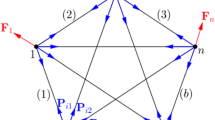Abstract
Aiming at the infeasibility of using quadrilateral-prisms to describe sharp shapes, an improved vertical stretch algorithm was proposed to generate three-dimensional (3D) hybrid meshes based on the quadrilateral mesh converted from triangles to discretize the geometric models with pinch-out features. A robust and automatic mesh generator was developed, which served as a preprocessing tool for simulating metal forming, water flows and transports. An initial mixed mesh composed of cuspate hexahedra, quadrilateral- and triangular-prisms was constructed to capture the sharp features of pinch-out regions effectively. Five splitting templates were established to divide the 3D elements derived from pinch-out sub-domains into tetrahedra and triangular-prisms. The concept of splitting points was defined, based on which the appropriate implementation mode of each splitting template could be determined, so as to achieve the conformity and consistency of common faces and edges between different kinds of elements. Two topological optimization templates were established to improve the quality of degenerated triangular-prisms and tetrahedra. A new pinch-out boundary quadrilateral insertion method was proposed to avoid the generation of cuspate hexahedra, which simplified the conformity treatment strategies and improved the quality of the resulting mesh to a certain extent. Practical applications confirmed that the hybrid mesh generation methods proposed in this paper could discretize the geometric models with pinch-out features precisely. The requirements on mesh conformity and refinement were also able to be fully satisfied.
Similar content being viewed by others
References
Aavatsmark, I., Eigestad, G.T., Klausen, R.A., Wheeler, M.F., Yotov, I.: Convergence of a symmetric MPFA method on quadrilateral grids. Comput. Geosci. 11, 333–345 (2007)
Benzley, S.E., Perry, E., Merkley, K., Clark, B., Sjaardema, G.: A comparison of all-hexahedral and all-tetrahedral finite element meshes for elastic and elastio-plastic analysis. In: Proceedings of the 4th International Meshing Roundtable, Albuquerque, NM, pp. 179–191 (1995)
Bernard, P.E., Remacle, J.F., Kowalski, N., Geuzaine, C.: Frame field smoothness-based approach for hex-dominant meshing. Comput. Aided Des. 72, 78–86 (2016)
Blacker, T.D., Stephenson, M.B.: Paving: a new approach to automated quadrilateral mesh generation. Int. J. Numer. Methods Eng. 32, 811–847 (1991)
Borouchaki, H., Frey, P.J., George, P.L.: Unstructured triangular-quadrilateral mesh Generation, application to surface meshing. In: Proceedings of 5th International Meshing Roundtable, Pittsburgh, PA, pp. 229–242 (1996)
Bowyer, A.: Computing Dirichlet tessellations. Comput. J. 24, 162–166 (1981)
Garimella, R.V., Shashkov, M.J., Knupp, P.M.: Triangular and quadrilateral surface mesh quality optimization using local parametrization. Comput. Methods Appl. Mech. Eng. 193, 913–928 (2004)
Ho-Le, K.: Finite element mesh generation methods: a review and classification. Comput. Aided Des. 20, 27–38 (1988)
Ito, Y., Shih, A.M., Soni, B.K.: Reliable isotropic tetrahedral mesh generation based on an advancing front method. In: Proceedings of the 13th International Meshing Roundtable, Williamsburg, VA, pp. 95–106 (2004)
Jamil, I.E., Al-Kayiem, H.H.: Simulation analysis of the oil/water structure in the downhole with presence of hydrocyclone separator. In: IOP Conference Series-Materials Science and Engineering, 100, Paper No. 012025 (2015)
Knupp, P.M.: A method for hexahedral mesh shape optimization. Int. J. Numer. Methods Eng. 58, 319–332 (2003)
Lee, C.K., Lo, S.H.: A new scheme for the generation of a graded quadrilateral mesh. Comput. Struct. 52, 847–857 (1994)
Li, H., Cheng, G.D.: New method for graded mesh generation of all hexahedral finite elements. Comput. Struct. 76, 729–740 (2000)
Meshkat, S., Talmor, D.: Generating a mixed mesh of hexahedra, pentahedra and tetrahedra from an underlying tetrahedral mesh. Int. J. Numer. Meth. Eng. 49, 17–30 (2000)
Owen, S.J., Staten, M.L., Canann, S.A., Saigal, S.: Q-morph: an indirect approach to advancing front quad meshing. Int. J. Numer. Methods Eng. 44, 1317–1340 (1999)
Rees, M.: Combining quadrilateral and triangular meshing using the advancing front approach. In: Proceedings of 6th International Meshing Roundtable, Park City, UT, pp. 337–348 (1997)
Schneiders, R.: A grid-based algorithm for the generation of hexahedral element meshes. Eng. Comput. 12, 168–177 (1996)
Shimada, K., Yamada, A., Itoh, T.: Automated conversion of 2D triangular mesh into quadrilateral mesh. In: Proceedings of International Conference on Computational Engineering Science, pp. 350–355 (1995)
Sorensen, K.A., Hassan, O., Morgan, K., Weatherill, N.P.: A multigrid accelerated hybrid unstructured mesh method for 3D compressible turbulent flow. Comput. Mech. 31, 101–114 (2003)
Staten, M.L., Kerr, R.A., Owen, S.J., Blacker, T.D.: Unconstrained paving and plastering: progress update. In: Proceedings of the 15th International Meshing Roundtable, Birmingham, AL, pp. 469–486 (2006)
Sun, L., Yeh, G.T., Lin, F.P., Zhao, G.Q.: Automatic quadrilateral mesh generation and quality improvement techniques for an improved combination method. Comput. Geosci. 19, 371–388 (2015)
Sun, L., Yeh, G.T., Lin, F.P., Zhao, G.Q.: An automatic method for complete triangular mesh conversion into quadrilateral mesh for multiple domain geometry. Terr. Atmos. Ocean. Sci. 27, 139–152 (2016)
Sun, L., Yeh, G.T., Ma, X.W., Lin, F.P., Zhao, G.Q.: Engineering applications of 2D and 3D finite element mesh generation in hydrogeology and water resources. Comput. Geosci. 21, 733–758 (2017)
Sun, L., Yeh, G.T., Zhao, G.Q.: Applications of quadrilateral and quadrilateral-prism mesh generation in overland and subsurface simulations. J. Hydrol. 548, 716–740 (2017)
Veyhl, C., Belova, I.V., Murch, G.E., Ochsner, A., Fiedler, T.: On the mesh dependence of non-linear mechanical finite element analysis. Finite Elem. Anal. Des. 46, 371–378 (2010)
Weatherill, N.P.: Delaunay triangulation in computational fluid dynamics. Comput. Math. Appl. 24, 129–150 (1992)
Yamakawa, S., Shimada, K.: Converting a tetrahedral mesh to a prism-tetrahedral hybrid mesh for FEM accuracy and efficiency. Int. J. Numer. Meth. Eng. 80, 74–102 (2009)
Yerry, M.A., Shephard, M.S.: A modified quadtree approach to finite element mesh generation. IEEE Comput. Graph. Appl. 3, 39–46 (1983)
Zhang, Y.J., Bajaj, C.: Adaptive and quality quadrilateral/hexahedral meshing from volumetric data. Comput. Methods Appl. Mech. Eng. 195, 942–960 (2006)
Acknowledgements
This project is supported by National Natural Science Foundation of China (Grant No. 51705290), the Young Scholars Program of Shandong University (No. 2018WLJH28), and Project funded by China Postdoctoral Science Foundation (Grant No. 2018 M640626).
Author information
Authors and Affiliations
Corresponding author
Additional information
Publisher’s note
Springer Nature remains neutral with regard to jurisdictional claims in published maps and institutional affiliations.
Rights and permissions
About this article
Cite this article
Sun, L., Zhao, G. & Yeh, GT. 3D hybrid mesh generation with an improved vertical stretch algorithm for geometric models with pinch-out features. Comput Geosci 25, 575–599 (2021). https://doi.org/10.1007/s10596-020-10026-x
Received:
Accepted:
Published:
Issue Date:
DOI: https://doi.org/10.1007/s10596-020-10026-x




